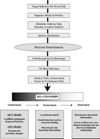Target selection and determination of function in structural genomics
- PMID: 12880206
- PMCID: PMC3366504
- DOI: 10.1080/1521654031000123385
Target selection and determination of function in structural genomics
Abstract
The first crucial step in any structural genomics project is the selection and prioritization of target proteins for structure determination. There may be a number of selection criteria to be satisfied, including that the proteins have novel folds, that they be representatives of large families for which no structure is known, and so on. The better the selection at this stage, the greater is the value of the structures obtained at the end of the experimental process. This value can be further enhanced once the protein structures have been solved if the functions of the given proteins can also be determined. Here we describe the methods used at either end of the experimental process: firstly, sensitive sequence comparison techniques for selecting a high-quality list of target proteins, and secondly the various computational methods that can be applied to the eventual 3D structures to determine the most likely biochemical function of the proteins in question.
Figures



Similar articles
-
A tour of structural genomics.Nat Rev Genet. 2001 Oct;2(10):801-9. doi: 10.1038/35093574. Nat Rev Genet. 2001. PMID: 11584296 Review.
-
NMR in structural genomics to increase structural coverage of the protein universe: Delivered by Prof. Kurt Wüthrich on 7 July 2013 at the 38th FEBS Congress in St. Petersburg, Russia.FEBS J. 2016 Nov;283(21):3870-3881. doi: 10.1111/febs.13751. Epub 2016 Jun 9. FEBS J. 2016. PMID: 27154589 Free PMC article.
-
Structural genomics reveals EVE as a new ASCH/PUA-related domain.Proteins. 2009 May 15;75(3):760-73. doi: 10.1002/prot.22287. Proteins. 2009. PMID: 19191354 Free PMC article.
-
Target selection for structural genomics.Nat Struct Biol. 2000 Nov;7 Suppl:967-9. doi: 10.1038/80747. Nat Struct Biol. 2000. PMID: 11104002 Review.
-
Structural genomics: a pipeline for providing structures for the biologist.Protein Sci. 2002 Apr;11(4):723-38. doi: 10.1110/ps.4570102. Protein Sci. 2002. PMID: 11910018 Free PMC article. Review. No abstract available.
Cited by
-
Small-scale, semi-automated purification of eukaryotic proteins for structure determination.J Struct Funct Genomics. 2007 Dec;8(4):153-66. doi: 10.1007/s10969-007-9032-5. Epub 2007 Nov 6. J Struct Funct Genomics. 2007. PMID: 17985212 Free PMC article.
-
Towards a comprehensive structural coverage of completed genomes: a structural genomics viewpoint.BMC Bioinformatics. 2007 Mar 9;8:86. doi: 10.1186/1471-2105-8-86. BMC Bioinformatics. 2007. PMID: 17349043 Free PMC article.
-
Towards fully automated structure-based function prediction in structural genomics: a case study.J Mol Biol. 2007 Apr 13;367(5):1511-22. doi: 10.1016/j.jmb.2007.01.063. Epub 2007 Jan 30. J Mol Biol. 2007. PMID: 17316683 Free PMC article.
-
Conference report--structural genomics: parsing the architecture of proteins highlights of the ABRF 2004--integrating technologies in proteomics and genomics, February 28-March 2, 2004; Portland, Oregon.MedGenMed. 2004 Apr 16;6(2):22. MedGenMed. 2004. PMID: 15266248 Free PMC article. No abstract available.
-
Use of a structural alphabet to find compatible folds for amino acid sequences.Protein Sci. 2015 Jan;24(1):145-53. doi: 10.1002/pro.2581. Epub 2014 Oct 25. Protein Sci. 2015. PMID: 25297700 Free PMC article.
References
-
- Terwilliger TC. Structural genomics in North America. Nat. Struct. Biol. Structural Genomics Supplement. 2000 Nov;2000:935–939. - PubMed
-
- Yokoyama S, Hirota H, Kigawa T, Yabuki T, Shirouzu M, Terada T, Ito Y, Matsuo Y, Kuroda Y, Nishimura Y, Kyogoku Y, Miki K, Masui R, Kuramitsu S. Structural genomics projects in Japan. Nat. Struct. Biol. Structural Genomics Supplement. 2000 Nov;2000:943–945. - PubMed
-
- Zhang C, Kim S-H. Overview of structural genomics: from structure to function. Curr. Opin. Chem. Biol. 2003;7:28–32. - PubMed
-
- Burley K. An overview of structural genomics. Nat. Struct. Biol. Structural Genomics Supplement. 2000 Nov;2000:932–934. - PubMed
-
- Blundell T, Mizuguchi K. Structural genomics: an overview. Prog. Biophys. Mol. Biol. 2000;73:289–295. - PubMed
Publication types
MeSH terms
Substances
Grants and funding
LinkOut - more resources
Full Text Sources

